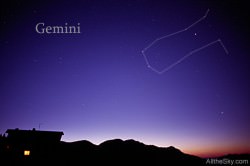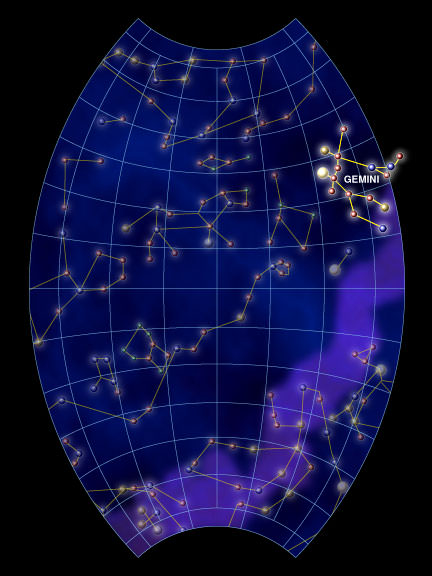Now that we’ve hunted down Orion and been bull ridin’ with Taurus, it’s time for us to discover a pair of celestial brothers – the Gemini twins. Gemini is one of the members of the zodiac which means the imaginary path the Sun, Moon and planets follow across the sky passes through the stars of this constellation. But what happens when you don’t have these solar systems objects to point the way to the pair? Then look over the top of Orion’s left shoulder and you’ll see two bright stars that live about a thumb’s length apart from each other – Castor and Pollux. For many of us, Gemini will be almost directly overhead at sky dark.
 The slightly fainter star to the northwest is named Castor, and his almost identical brother star angled away to the southeast is Pollux. If you live where skies are dark, give your eyes plenty of time to adjust and you will begin to see the fainter stars that make up the stick figures of their bodies. Their “feet” will always point towards Orion. Once you understand the positions of the stars, it isn’t hard to see how ancient civilizations connected these two stars as twins! The ancient Romans saw the brothers Romulus and Remus, the two heroes that founded Rome. The Greek astronomers saw the twins Castor and Pollux, sons of the god Zeus. Oddly enough, both cultures believed the brothers were raised by the half-man, half-bull centaur called Chiron. Perhaps because of the nearby constellation of Taurus? It was Chiron who sent them to help Jason and the Argonauts in their quest to find the golden fleece. Legend has it that the twins rescued Jason’s ship from a killer storm and thus earned their place in the sky. Other stories say the twins were born of different fathers, making one mortal and one immortal. Pollux, who would live forever, was an excellent boxer. Castor, who would age normally, was an excellent horseman. When both were called upon to fight in the Trojan war, Castor was killed. Pollux love for his brother was so strong that he could not bear to be parted from him, so he begged Zeus to place them both in the sky as stars. The Arabs also saw this pair of stars as twins, while the Chinese referred to them as Yin and Yang!
The slightly fainter star to the northwest is named Castor, and his almost identical brother star angled away to the southeast is Pollux. If you live where skies are dark, give your eyes plenty of time to adjust and you will begin to see the fainter stars that make up the stick figures of their bodies. Their “feet” will always point towards Orion. Once you understand the positions of the stars, it isn’t hard to see how ancient civilizations connected these two stars as twins! The ancient Romans saw the brothers Romulus and Remus, the two heroes that founded Rome. The Greek astronomers saw the twins Castor and Pollux, sons of the god Zeus. Oddly enough, both cultures believed the brothers were raised by the half-man, half-bull centaur called Chiron. Perhaps because of the nearby constellation of Taurus? It was Chiron who sent them to help Jason and the Argonauts in their quest to find the golden fleece. Legend has it that the twins rescued Jason’s ship from a killer storm and thus earned their place in the sky. Other stories say the twins were born of different fathers, making one mortal and one immortal. Pollux, who would live forever, was an excellent boxer. Castor, who would age normally, was an excellent horseman. When both were called upon to fight in the Trojan war, Castor was killed. Pollux love for his brother was so strong that he could not bear to be parted from him, so he begged Zeus to place them both in the sky as stars. The Arabs also saw this pair of stars as twins, while the Chinese referred to them as Yin and Yang!
 But there’s a lot more “twins” here than can just be seen with your eyes alone. Two million year old Castor is also a very special type of “twin” star called a visual binary. This means it has another star that can be seen with a telescope very close to it. The two stars aren’t physically connected to each other, but its twin star is also a twin star! Pollux is also very special, too. Why? Because on on June 16, 2006 it was announced that there is planet just about twice the size of Jupiter orbiting it! The planet’s name is Polydeuces – another derivation of the word twin. In real life, this pair of stars couldn’t be more different than each other if they tried. Castor is a hot, blue/white A-type star – a multiple system located almost 50 light years away from Earth. Pollux is a cooler, singular star – a 35 light year distant orange giant that’s not only more massive than our Sun, but probably younger, too.
But there’s a lot more “twins” here than can just be seen with your eyes alone. Two million year old Castor is also a very special type of “twin” star called a visual binary. This means it has another star that can be seen with a telescope very close to it. The two stars aren’t physically connected to each other, but its twin star is also a twin star! Pollux is also very special, too. Why? Because on on June 16, 2006 it was announced that there is planet just about twice the size of Jupiter orbiting it! The planet’s name is Polydeuces – another derivation of the word twin. In real life, this pair of stars couldn’t be more different than each other if they tried. Castor is a hot, blue/white A-type star – a multiple system located almost 50 light years away from Earth. Pollux is a cooler, singular star – a 35 light year distant orange giant that’s not only more massive than our Sun, but probably younger, too.
 If you have binoculars or a telescope, be sure to take a look right around Castor’s big toe on a dark night. Here you will see colorful and bright galactic star cluster known as Messier Object 35. A large telescope will also reveal another nearby star cluster, NGC 2158, too. Another “twin”! There is also a planetary nebula called the “Eskimo” (NGC 2392) near the “arm” of the twin on the left. There are many other clusters and nebulae which are part of the constellation of Gemini, but most are too faint to seen without a large telescope.
If you have binoculars or a telescope, be sure to take a look right around Castor’s big toe on a dark night. Here you will see colorful and bright galactic star cluster known as Messier Object 35. A large telescope will also reveal another nearby star cluster, NGC 2158, too. Another “twin”! There is also a planetary nebula called the “Eskimo” (NGC 2392) near the “arm” of the twin on the left. There are many other clusters and nebulae which are part of the constellation of Gemini, but most are too faint to seen without a large telescope.
Have fun with all your new knowledge of Gemini – the twins!
Gemini Map courtesy of the University Corporation for Atmospheric Research (UCAR), Mythological Figures courtesy of Stellarium, Constellation photography courtesy of Till Credner, M35 and NGC 2158 courtesy of N.A.Sharp/NOAO/AURA/NSF. Thank you so much!

